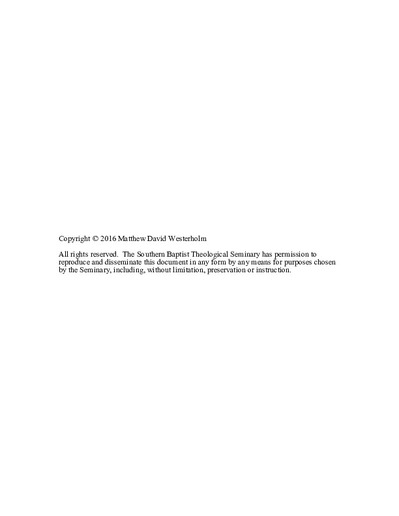| dc.description.abstract | This dissertation critically evaluates the portrayal of the doctrine of inaugurated eschatology in an identified core repertory, the most-used contemporary congregational worship songs in churches in the United States from 2000 through 2015.
Chapter 2 explores views on the role of congregational singing as it relates to the presence of God and the spiritual formation of the believer. It compares Edith Humphries’ concept of the worship service as “entrance” with Ryan Lister’s view that God’s presence is both a goal and a means of accomplishing his purposes. Then, using the work of James K. A. Smith and Monique Ingalls, chapter 2 explores the role congregational song plays in forming the identity of churches and believers. The chapter concludes by suggesting that the aesthetic paradigm of Nicholas Wolterstorff has useful implications for the manner in which congregational singing serves as the occasion for entering the divine presence.
Chapter 3 maps a typology of themes related to the doctrinal umbrella of “inaugurated eschatology,” as codified by George Ladd and now a widely-used term in evangelical scholarship, so as to provide nuanced categories by which one can evaluate the content and scope of eschatological thought in American evangelical life. After a brief survey of the doctrine’s historical development, tracing the contributions of George Ladd, Anthony Hoekema, and “progressive dispensationalism,” the dissertation traces the biblical data to highlight ways in which Scripture speaks of the kingdom of God’s current presence (the “already”) and future arrival (the “not yet”). The chapter then considers believers’ experience of the “already” and the “not yet” in language of affection, spatiality, and chronology.
Chapter 4 traces these eschatological themes in American evangelical hymnody from ca. 1700 through 1985, addressing a few representative hymns from each hymnic era by way of illustration. Drawing upon the work of Stephen Marini, Eric Routley, Richard Crawford, and others, the chapter surveys select examples of American evangelical hymnody from four time periods in US history (beginning in 1737) and finds that many of these historic hymns contain substantive reflections upon robust eschatological themes.
Chapter 5 surveys the core repertory of CWM across the span of years from 2000 to 2015 for a portrayal of the themes of inaugurated eschatology. Using Richard Crawford’s concept of “core repertory,” it synthesizes CCLI reports of song usage over a defined recent period (2000 to 2015) to identify a core group of songs for analysis, and derives a body of 83 songs. Using the lens of inaugurated eschatology developed in chapter 3, it concludes that elements of “not yet” are underrepresented in contemporary evangelical congregational song.
Chapter 6 proposes practical ways that church leaders of worship can better represent these themes as they plan services for the health and sustainable growth of their churches. Chapter 7 summarizes each of the chapters, draws implications, and suggests areas for further research. | en_US |

